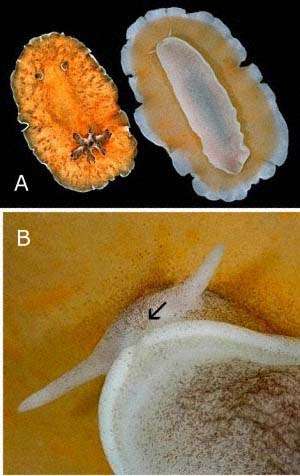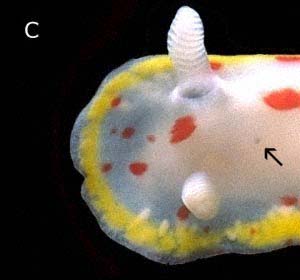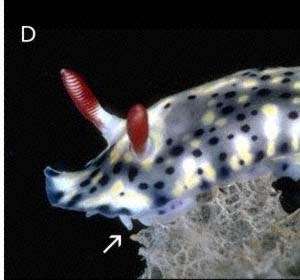
The nudibranch head
PHOTO
A,B. Dorsal and ventral views of Platydoris sanguinea (Dorididae). B, closeup of underside showing head, mouth (arrowed) and oral tentacles. C. Dorsal view of front of Chromodoris hunteri (Chromodorididae) showing pair of white lamellate rhinophores and left eye (arrowed), partially visible through the skin. D. Front of Hypselodoris infucata (Chromodorididae) showing oral tentacles (left one arrowed) partially hidden by the mantle skirt. PHOTOS: Bill Rudman.
In most animals the 'head' is easy to find. It is at the front of the body, has a mouth and sense organs like eyes, ears, nose or antennae. The 'head' in a dorid nudibranch is a bit more confusing because usually all that you can see as the slug is crawling along are a pair of prominent rhinophores, which 'smell' chemicals in the water. The eyes are very small and usually invisble, but can sometimes be seen as little black specks hidden deep beneath the skin, behind the rhinophores. The mouth can only be seen if you turn the slug over, because it is hidden beneath the mantle skirt. I have described the function of the rhinophores on a separate page. Here is a little about the other parts of the 'head'.
EYES: the sea slug eyes sit deep inside the body on top of the brain. These small black spheres cannot see images but are able to distinguish light and dark. They may warn the slug of predators by detecting shadows, and they are probably useful in helping the slug's internal body clock stay timed to day and night. (see photo C)
ORAL TENTACLES: In dorids these are usually tapering cylindrical feelers on either side of the mouth. They are primarily concerned with touch, helping the slug feel its way but they probably also can sense chemicals. (See photos B,D)
MOUTH: The mouth usually opens at the end of a short 'snout' with an oral tentacle on each side. It is quite unlike our mouth, being just an opening to allow the slug's feeding apparatus (and associated radular teeth), to come out and bite, rasp or suck in its food. (see photo B)


Rudman, W.B., 1999 (March 26) The nudibranch head. [In] Sea Slug Forum. Australian Museum, Sydney. Available from http://www.seaslugforum.net/factsheet/headeudo
Related messages
-
Mouth parts of some chromodorids
From: Bob Whorton, July 1, 2005 -
Chromodoris tinctoria - head waggling behaviour
From: Kheong Sann Chan, November 11, 2002
